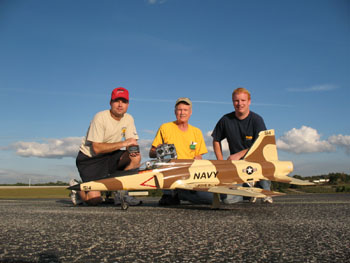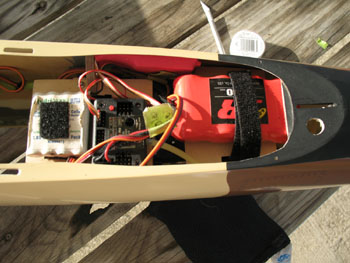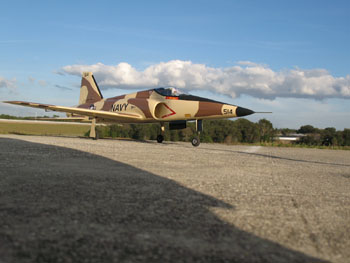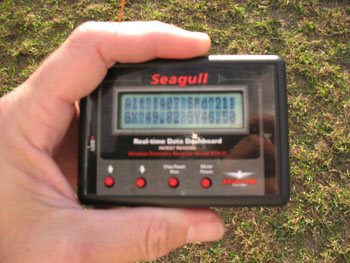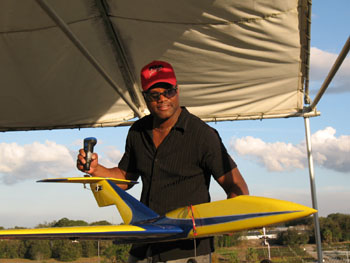Speed Runs are Fun By Bob Violett
Chuck (Sparky), BV, and Dustin with the Spektrum guided Electra The best way to confirm design theory is to put it to an appropriate test. The best way to test that an intended high performance package actually meets the design goals, is to measure the achievable velocity. Although the Electra Jet was not designed solely for speed, it was intended to be efficient. The 60", 710 square inch wing allows the Electra to perform excellent pattern style maneuvers as well as remain very docile in the landing pattern. We chose the "Eagle Tree" telemetry system to measure the velocity because in early "Ultra Bandit" testing, it compared very closely to a JetCat airspeed recording device when both systems were flight tested in this big turbine powered model. The hand held "Dash Board" unit provides instantaneous read out. Since our Camo Electra is equipped with the extended main gear doors (BVM# E2000-65), we chose it to install the Eagle Tree with a pitot tube. There was some rearrangement of internal electronic components required to maintain the Center of Gravity. The BVM Electric VioFan with a Neu 1521 motor, Castle Creations HV110 ESC, was the power unit. It was a stock, off-the-self product. The weather was typical for a January day in Central Florida with a temperature of 83°F, mild relative humidity and a 7mph 45°crosswind. The first flight yielded speeds in the high 180's and mid 190's. On one pass however, Dustin noticed that the left main gear was not fully retracted, so I landed immediately. This model had flown on 10S power previously. The forces involved with that power system were not sufficient to pull the wheel and strut out of the wing. We adjusted the linkage at the servo wheel, tightening it two full turns. Now, the strut door would fit firmly against the bottom wing skin. We know from our experience in the early days of piston D/F speed runs, that a "hanging gear" can create enough drag to loose 15-20 mph. As the Electra Jet kit instructions emphasize - spend that extra few minutes to get the mechanical linkage correct, and then it is right forever. The second attempt was very successful. At the end of each low, fast fly-by I zoom climbed the model and cut the power about halfway up. The power remains off for the turn around maneuver and during half of the dive. I then ease the throttle up and concentrate on flying smooth, straight and level for about 1,000 ft. On each pass, Chuck McClellan read out the Eagle Tree Dash Board display as the model continued to accelerate. The Eagle Tree registered 202, 205, 209, 210, and finally 211 mph. Dustin operated a camera to properly record the event and offered some valued coaching. The reason that the speeds increased with each succeeding pass is that the batteries warm up and yield more power. Pilot technique is very important as well, and so hearing Chuck read out the speeds helps refine that technique. The top speed is attained at the end of each pass. Can We Go Faster? Of course we can. Our bench testing with larger motors and more cells confirm this. But, as we have said before, "speed isn't everything". It does however, exhibit the efficiently of the BVM products and offers our customers confidence in these products and those yet to come. Our Thanks to RCACF member Gary Robinson for helping us with the photos and witnessing the event. As you can see, Gary is already into the electric jet-like models. Foot Note:
Contact Us |
